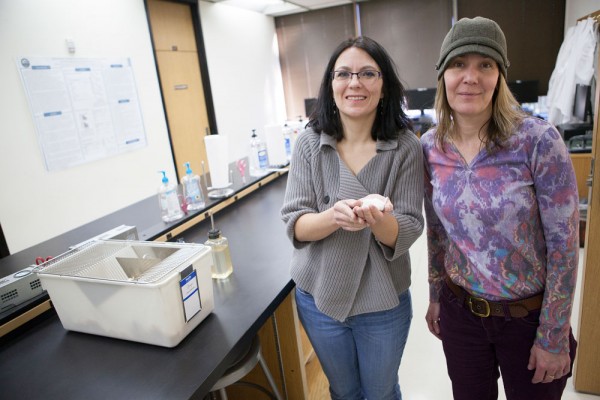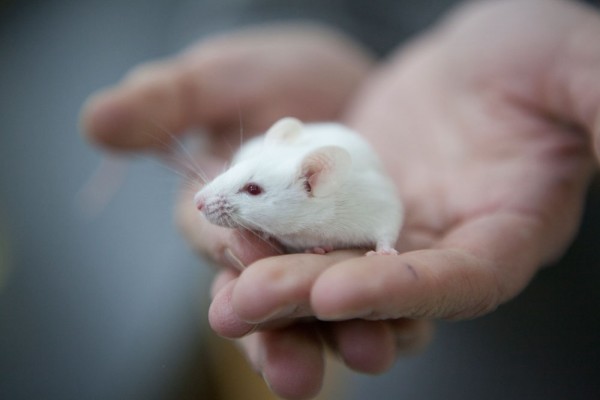Research: The trouble with Splenda
by Kathleen McCoy |

Gwen Lupfer, psychology professor, and Khrys Duddleston, microbiology professor, will collaborate to study how Splenda leads to weight gain. (Photo by Philip Hall/University of Alaska Anchorage)
The facts are stacking up: Scientific studies over the last few years indicate that artificial sweeteners-created to decrease sugar consumption and help fight obesity-may actually be contributing to the problem.
The work has developed in both psychology and microbiology research labs in the United States, as well as Canada and Israel.
Psychologists have tracked eating behavior in rodents consuming food or liquid laced with artificial sweeteners. Study designs varied widely, but all pointed to the same result: Consuming artificial sweeteners leads to over eating and weight gain. It is as if artificial sweeteners confuse an animal's natural ability to manage calories based on tasting something sweet.
Microbiologists have done their own work. They have confirmed that when rodents consume artificial sweeteners, their gut microbes can change, inducing glucose intolerance which may influence weight gain.
Now at UAA, two professors will link both areas of research, perhaps for the first time. Working together are Gwen Lupfer, a professor of psychology interested in behavioral neuroscience, and Khrys Duddleston, a microbiologist focused on the interactions between the host and its gut microbial community as it relates to disease.
Their collaboration is made possible by a $25,000 Innovate research grant; they'll employ two undergraduate researchers and hope for results by December 2015.
These two have worked together already on a 2012 study that documented ethanol-loving hamsters had evolved to love alcohol, rare among animals, because the rye grass seeds they collect as food and store in their pouches partially ferment.
This time, their subjects will be mice and their research topic is Splenda, or sucralose, an artificial sweetener derived from sugar that was discovered in the 1970s and approved for use in the U.S. in the 1990s.
Lupfer has already completed one study confirming that mice fed a snack of grits laced with Splenda will overeat their regular supply of food and subsequently gain weight. The mice that eat grits sweetened with regular sugar don't overeat their regular food supply.

Ginger gained weight in a recent study using artificial sweeteners. (Photo by Philip Hall/University of Alaska Anchorage)
The day I met the two in Lupfer's lab, she held Ginger in her hands, the fattest little mouse from a recent artificial sweetener experiment.
"The real sugar mice learn that when food is sweet, it fills them up more, their blood sugar increases, they don't need to eat as much to get full," Lupfer said.
But the mice conditioned on artificial sweeteners don't learn that.
"If you use artificial sweeteners all the time, that sugar taste is no longer a cue that your blood glucose is going to go up," Lupfer said. "Because it may not. So you don't have the normal hormonal release that you otherwise would. And then you overeat. And it is not satisfying because you're not getting the signals."
One thing they already know is the body reacts immediately to a sweet taste. "Your pancreas does not wait for your blood glucose to actually go up in order to release insulin. Just the taste of something sweet does that, like salivating when you smell food. "It's an anticipatory response," Lupfer said.
So, their joint project will attempt to figure out how changes in the gut microbial community may contribute to that anticipatory response that psychologists have documented, Duddleston said.
They've designed a series of experiments to condition mice to learn that a sweet taste predicts caloric increases (sugar), or, that a sweet taste does not predict a caloric increase (Splenda). Then, they will compare the gut microbial communities of each group by studying the contents of their fecal material.
Next, they'll introduce antibiotics in certain animals in both groups, a process that will wipe out their gut microbial community. Then they'll co-house select mice, one that has been treated with antibiotics and one that was not. Basically, one mouse will have no gut microbes, and the second mouse still will. Since mice eat each others' fecal matter, the mouse with no gut microbes quickly will repopulate with the gut microbes of the animal it lives with.
"We will have mice who consumed Splenda and learned sweet tastes don't fill them up," Lupfer said. "We'll swap their gut microbes with a mouse that only consumed real sugar."
After the swap the mice will be monitored again for overeating behavior.
They say they'll be able to tell whether it was the learned experience of tasting something sweet (that did or did not lead to a big blood glucose change), or the changed make up of the gut microbial community, that drives the overeating of sweet foods.
The link between psychology and the gut microbial community is getting stronger all the time, Lupfer said, mostly because microbiology findings are exploding. Duddleston agreed.
"There is evidence that the gut microbial community has an influence on mood, anxiety and depression, circadian rhythms," Duddleston said. "It affects everything."
Said Lupfer: "Psychologists are going to have to start caring about gut microbes."
A version of this story by Kathleen McCoy appeared in the Alaska Dispatch News on Sunday, March 15, 2015.
 "Research: The trouble with Splenda" is licensed under a Creative Commons Attribution-NonCommercial 4.0 International License.
"Research: The trouble with Splenda" is licensed under a Creative Commons Attribution-NonCommercial 4.0 International License.














